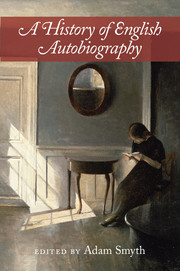Book contents
- Frontmatter
- Dedication
- Contents
- List of contributors
- 1 Introduction: The range, limits, and potentials of the form
- PART 1 AUTOBIOGRAPHY BEFORE ‘AUTOBIOGRAPHY’ (CA. 1300–1700)
- 2 Medieval life-writing: Types, encomia, exemplars, patterns
- 3 Autobiographical selves in the poetry of Chaucer, Gower, Hoccleve, and Lydgate
- 4 The radicalism of early modern spiritual autobiography
- 5 Inscribing the early modern self: The materiality of autobiography
- 6 Re-writing revolution: Life-writing in the Civil Wars
- 7 Money, accounting, and life-writing, 1600–1700: Balancing a life
- PART 2 RELIGION, GENDER, THINGS (CA. 1700–1800)
- PART 3 THE MANY NINETEENTH CENTURIES (CA. 1800–1900)
- PART 4 RELATIONAL LIVES AND FORMS OF REMEMBERING (CA. 1890–1930)
- PART 5 KINDS OF COMMUNITY (CA. 1930-CONTEMPORARY)
- Index
- References
6 - Re-writing revolution: Life-writing in the Civil Wars
from PART 1 - AUTOBIOGRAPHY BEFORE ‘AUTOBIOGRAPHY’ (CA. 1300–1700)
Published online by Cambridge University Press: 05 March 2016
- Frontmatter
- Dedication
- Contents
- List of contributors
- 1 Introduction: The range, limits, and potentials of the form
- PART 1 AUTOBIOGRAPHY BEFORE ‘AUTOBIOGRAPHY’ (CA. 1300–1700)
- 2 Medieval life-writing: Types, encomia, exemplars, patterns
- 3 Autobiographical selves in the poetry of Chaucer, Gower, Hoccleve, and Lydgate
- 4 The radicalism of early modern spiritual autobiography
- 5 Inscribing the early modern self: The materiality of autobiography
- 6 Re-writing revolution: Life-writing in the Civil Wars
- 7 Money, accounting, and life-writing, 1600–1700: Balancing a life
- PART 2 RELIGION, GENDER, THINGS (CA. 1700–1800)
- PART 3 THE MANY NINETEENTH CENTURIES (CA. 1800–1900)
- PART 4 RELATIONAL LIVES AND FORMS OF REMEMBERING (CA. 1890–1930)
- PART 5 KINDS OF COMMUNITY (CA. 1930-CONTEMPORARY)
- Index
- References
Summary
On the face of it, the two writers upon whom this chapter will ultimately focus – Anne, Lady Halkett and Nehemiah Wallington – have little in common. Halkett (née Murray, 1622–1699) was a Royalist member of the gentry who maintained a life-long commitment to the Church of England, whereas Wallington (1598–1658), a London wood turner, was a puritan supporter of Parliament. Their experiences are also geographically distinct; although Halkett was born in London, her parents were Scottish and she lived most of her adult life in Scotland (predominantly in Fife), whereas Wallington was born, bred, and died in the parish of St Leonard's in Eastcheap. In terms of sex, politics, theology, geography, and social position, then, Halkett and Wallington occupy polarised positions. Despite their divergent politics, however, Wallington's and Halkett's writing practices share a surprising amount in common and together their texts display a number of characteristics which are symptomatic of significant developments in Civil War life-writing more broadly. For both, writing was a regular exercise with devotional meaning centred on self-examination (which meant exploring their relationship with God, their household, and (inter)national political events), to which they remained committed throughout their adult lives. While both wrote in manuscript, their texts bear markers of potential print publication; both are also avid readers of printed books, pamphlets, and proclamations who frequently engage with ‘public opinion’. They also share an exceptional status in terms of their prolific output: according to Wallington's own account, he wrote fifty different ‘notebooks’; according to Halkett's eighteenth-century biographer, she produced twenty-one ‘Books’ (defined as ‘Select and Occasional Meditations’). From a twenty-first-century perspective, however, neither ‘notebook’ nor ‘meditation’ are classifications which are generally associated with ‘autobiography’; indeed, their generic recalcitrance reinforces Smyth's proposition that ‘generic unfixity and experimentation was … a defining characteristic of early modern autobiography’ (Smyth 2010, 14).
Significantly, the material differences between Wallington and Halkett simultaneously gesture towards the most striking characteristic of mid-seventeenth-century ‘autobiographical’ material: its astonishing diversity. Across Britain, men and women of a range of social positions (from artisan to aristocrat), with often highly nuanced political awareness (frequently founded upon an unparalleled array of religious identifications), recorded their lives and commented upon contemporary events in texts which survive in unprecedented numbers.
- Type
- Chapter
- Information
- A History of English Autobiography , pp. 70 - 85Publisher: Cambridge University PressPrint publication year: 2016
References
- 2
- Cited by



